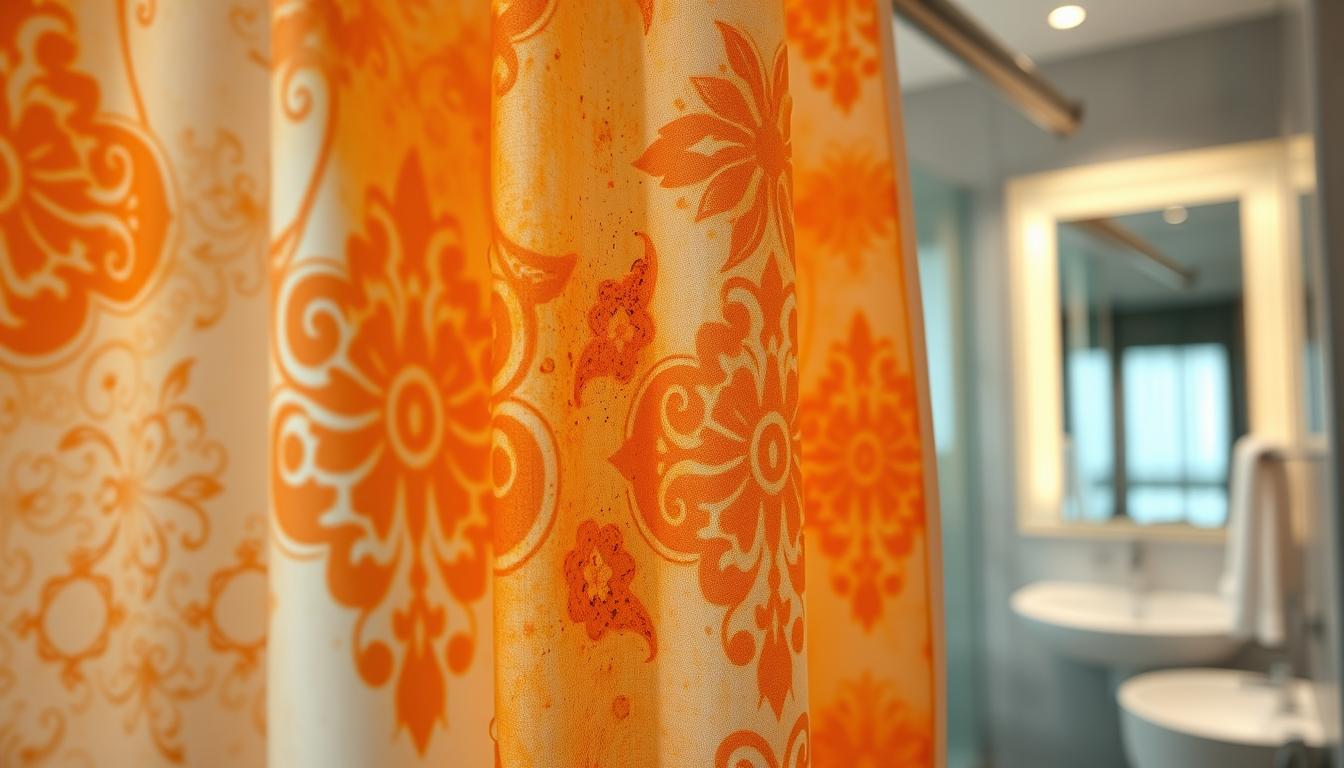Why Your Shower Curtain Turns Orange Explained
Your shower curtain plays a key part in keeping your bathroom neat. But, it often gets ugly orange stains. These marks mostly come from minerals in the water, mold, and bacteria. Fabric curtains get these stains easier because of minerals like iron and magnesium in hard water.
Even though fabric curtains are safer—no bad gases like those from plastic or PVC—they’re hard to clean well in a washing machine. The damp area in your bathroom makes bacteria and mold grow faster. This makes the curtain look bad.
To have a clean bathroom, you need to take care of your curtain regularly. Using safe cleaners like powdered oxygen bleach helps. It gets rid of the dirt and stains while keeping things natural and free from harsh chemicals.
Understanding the Causes of Shower Curtain Discoloration
Figuring out why shower curtains get orange stains is important. It’s the first step to prevent these stains. Taking care of these issues regularly helps avoid orange buildup. It also reduces the times you need to clean these stains off.
Iron and Magnesium Buildup
Iron and magnesium in your water can make shower curtains orange. These metals mix with soap and air to form rust-like spots. Using a water softener can prevent these stains.
Presence of Pink Mold
The “pink mold” is actually a reddish-orange bacteria called Serratia marcescens. It loves moist, warm places like shower walls and curtains. Keep your bathroom clean and well-ventilated to avoid this bacteria. Chlorine bleach works well against pink mold stains.
Bacterial Growth from Moisture
A damp bathroom can cause bacteria to grow, leaving stains on the shower curtain. Dry your shower curtain after use and wash it every 1 to 2 months. These steps can greatly reduce bacteria.
Taking these actions helps keep your bathroom cleaner.
To further illustrate these points, consider the following comparative measures:
| Cause | Preventative Measures | Cleaning Solutions |
|---|---|---|
| Iron and Magnesium Buildup | Use of water softeners | Regular hand washing, softener installation |
| Pink Mold | Regular cleaning and improved ventilation | Chlorine bleach, enzyme sprays |
| Bacterial Growth | Drying curtains, regular washing | Baking soda and vinegar, lemon juice |
By knowing these causes, you can avoid orange stains on shower curtains. This keeps your bathroom looking fresh and clean.
Why Does Shower Curtain Turn Orange?
Ever wonder why your shower curtain turns orange? It’s a common issue for many people. The main reason is due to iron or other metals in the water. These metals mix with the curtain material, causing the orange spots over time.
Another cause is tiny organisms like Serratia marcescens bacteria. They love warm, moist places, like your bathroom. This makes the shower curtain a perfect spot for them to grow, adding to the orange stain. For more details, check out this article.
To understand why does shower curtain turn orange, it’s important to know about minerals and bacteria. Also, poor air flow in the bathroom can make things worse. It lets moisture stick around, which encourages mold and mildew. An exhaust fan can help remove damp air.
Keeping your curtain clean is key. Wash it every one to two months to fight against bacteria and mineral build-up. Always dry it well after each shower to stop mold and mildew. For even better results, use warm water with detergent, white vinegar, and baking soda when you wash it.
A water softener can help remove orange stains from shower curtain by filtering hard minerals from water. Regular use of a shower spray can also prevent mold. Plus, good ventilation in the shower area keeps it clean and stain-free.
Mold and mildew can be different colors, including orange and brown. It’s crucial to clean regularly. With just 10 minutes four times a year, you can keep your curtain looking good. Doing this, along with drying and ventilating well, makes for a healthier bathroom.
Health Risks Associated with Orange Stains
Orange stains on shower curtains are more than a simple eyesore; they bring serious health risks. Often, these stains are due to bacteria such as Serratia marcescens. This bacteria can cause major health problems. Being near a stained curtain can harm your health and bathroom cleanliness.
Potential Respiratory Issues
Stained shower curtains can lead to breathing problems. Your bathroom’s warm and wet setting is perfect for harmful bacteria and mold to grow. These can make breathing issues like asthma worse and cause chronic bronchitis.
To prevent these health issues, clean your shower curtain often. Mold grows quickly in damp places, harming the air you breathe. The U.S. Environmental Protection Agency (EPA) says to tackle mold right away, as no amount of mold is safe.
Skin Irritations
Stained shower curtains might also irritate your skin. Bacteria like Serratia marcescens can infect your skin, leading to rashes. Being in contact with these bacteria often can make your skin uncomfortable often.
To lower this risk, think about getting a water softener. This can lessen mineral stains and you should dry your shower curtain well after washing it. If you find mold, clean it quickly with baking soda and laundry detergent, following the EPA’s advice.
For more information on how pollutants affect your home, check out how to maintain home environments.
In summary, it’s vital to handle these health risks. Keeping your shower curtain clean, enhancing air flow in your bathroom, and using the right cleaning methods can lower these risks. Good bathroom cleanliness greatly cuts down the dangers of a stained shower curtain, making your house safer.
How to Prevent Orange Stains on Your Shower Curtain
To keep your shower curtain free from orange stains, you need a plan. This includes cleaning regularly, managing moisture, and checking your water. These steps will help keep your bathroom looking and feeling fresh.
Regular Cleaning and Maintenance
Regularly washing your shower curtain is key. You should do this every month or two, depending on how often you use your shower. This keeps away the iron and metals that cause those orange marks. Try using natural cleaners, like baking soda and vinegar, to tackle stains.
Adding ½ cup of baking soda and ¼ cup of vinegar to the rinse cycle fights mildew. This extra step will boost your curtain’s defense against unwanted growths.
Improving Bathroom Ventilation
Mold and mildew don’t stand a chance in well-ventilated bathrooms. The pink mold, Serratia marcescens, loves moisture and warmth. Open a window or run an exhaust fan to keep the air moving. This will cut down on the dampness that mold thrives in.
Always dry your shower curtain after using it. This simple habit prevents mold and mildew from taking hold.
Using Water Filtration Systems
High levels of iron and magnesium in your water can lead to stains. A water filtration system can be a great solution. It reduces these minerals in your water, helping keep your curtain clearer. Together with regular cleaning, this approach keeps your bathroom looking great.
By following these guidelines, you can avoid those pesky orange stains. Clean regularly, control the moisture, and treat your water. These actions will keep your bathroom environment healthy, pleasant, and spotless.
Summary Table of Preventive Measures
| Preventive Measure | Details |
|---|---|
| Regular Cleaning | Wash every 1-2 months with natural cleaners like vinegar and baking soda. |
| Improving Ventilation | Use an exhaust fan or open windows to enhance air circulation and reduce moisture. |
| Water Filtration Systems | Install filters to reduce iron and magnesium levels, minimizing staining potential. |
Effective Cleaning Methods for Shower Curtain Stains
Shower curtains often get ugly orange stains from metals in water. Keeping them clean needs regular care and the right methods. Here are some good ways to clean stains using everyday products and special cleaners.
Using Baking Soda and Vinegar Mix
Making a paste of baking soda and vinegar works well on shower curtain stains. This cleaner is safe and non-toxic, perfect for families with kids and pets. Spread the paste on stains, wait a few minutes, then scrub them off. Using this mix regularly can stop stains from gathering.
Applying Lemon Juice Solutions
Lemon juice is also great for cleaning stains naturally. Just spray it on the stains, let it sit, then rinse well. Lemon juice’s acid helps dissolve the stains, offering a simple and eco-friendly cleaning option.
Specialty Cleaners Containing Oxalic Acid
For tough stains, cleaners with oxalic acid are effective. However, they must be used carefully due to their strong nature. Always follow the instructions and ventilate the area well. Make sure to rinse the curtain thoroughly afterward. Cleaning it every 1 to 2 months will keep it looking fresh.
Looking for more ways to keep your shower curtain clean and stain-free? Discover more tips here or learn about other cleaning techniques.
| Cleaning Method | Benefits | Precautions |
|---|---|---|
| Baking Soda and Vinegar Mix | Effective and non-toxic | Ensure thorough rinsing |
| Lemon Juice Solutions | Natural and easy to use | May need multiple applications |
| Oxalic Acid Cleaners | Powerful for severe stains | Use with caution, follow instructions |
Maintaining a Clean and Stain-Free Shower Curtain
Keeping your bathroom clean and healthy is important. Make sure to clean your shower curtain every month. This keeps away harmful bacteria and mold. Cleaning regularly makes the curtain look good and fresh. Though plastic shower curtains are cheap to replace, cleaning them saves money over time.
Monthly Cleaning Routine
Different shower curtains need different cleaning methods. Wash cloth curtains every three months, or more if they get wet often. Plastic liners should be cleaned every month because they’re exposed to more moisture. Use the washing machine on a gentle cycle. Use warm water, detergent, and vinegar to fight mold. Throw in cotton towels to help scrub the dirt off.
Using Non-Toxic Cleaning Agents
Choosing non-toxic cleaners is good for you and the planet. Use safe cleaning agents like Oxiclean, Bio Kleen, or Molly’s Suds. These keep chemicals away and clean well. A mix of vinegar and warm water can clean tough spots and remove mold. Add tea tree oil for extra mold-fighting power. This approach is both healthy and eco-friendly.
These tips and using green cleaners can keep your shower curtain clean. Your bathroom will be a safe, clean place for daily use.

Hey there, I’m Alex Hanson and I’m passionate about all things covers! Whether you’re looking for a car seat cover to protect your vehicle or an oven cover to keep your kitchen clean, I’m here to help. With years of experience in the industry, I have plenty of knowledge and insights to share with my readers. So, if you care about protecting your belongings and making them look their best, you’re encouraged to read my blog as I explore the perfect cover for every need.







